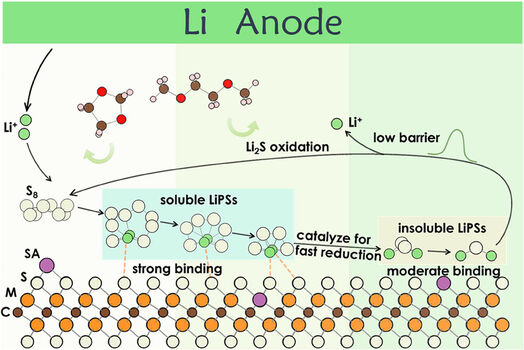New research shows that introducing single atoms into specialised two-dimensional materials called MXenes, and subtly straining their structure, can significantly accelerate chemical reactions and prevent the “wandering” of polysulfides, giving lithium-sulphur batteries greater performance and stability.
Lithium-sulphur (Li-S) batteries hold the promise of revolutionising energy storage thanks to their extremely high theoretical capacity and low cost. Their practical use, however, is hindered by two major challenges: the shuttle effect, in which soluable polysulfides move between the anode and cathode, and the slow chemical reactions involved in the conversion of sulphur.
A new study, led by researchers from China, the USA, and IT4Innovations at VSB-TUO, demonstrates that these obstacles can be overcome by combining two modern approaches: embedding single atoms (SA) into sulphur-functionalised MXenes (S-MXenes) – two-dimensional materials with excellent electrical conductivity and chemical stability — and applying so-called strain engineering, which involves gently stretching or compressing the material’s crystal lattice.
Using advanced calculations and the supercomputers at IT4Innovations, the team identified 73 promising S-MXene combinations. The best results were achieved by incorporating nickel, copper, and zinc atoms itno S-MXenes. The Gibbs free energy barrier dropped by up to 75%, outperforming conventional graphene-based catalysts.
A metaphor for an easy-to-understand illustration:
Imagine an MXene as a sprawling city with wide roads, where polysulfides are cars moving freely. Without guidance, the cars crash, get lost, and create chaos – this is the shuttle effect. Single atoms embedded in the MXene act like smart traffic controllers: they stop cars in the right places, guide them along the correct routes, and speed up their journey – controlling the polysulfides, accelerating chemical reactions, and preventing them from “escaping” the city. By adding a gentle strain to the structure, the roads are subtly adjusted, allowing the controllers to work even more efficiently – cars move smoothly and swiftly.
The mechanism is fascinating: the single atoms alter the electron distribution on the MXene surface, optimise the adhesion between the catalyst and polysulfides, and disrupt unfavourable energy interactions between intermediates. Strain in the crystal lattice shifts the energy levels of the metal atoms, enhancing their chemical affinity for the reaction intermediates

The team also developed a machine learning model that can accurately predict the binding strength between polysulfides and single atoms on MXenes, enabling the targeted design of new, highly efficient catalysts. These discoveries pave the way for designing cathode materials that combine high electrical conductivity, effective polysulfide retention, and fast reaction kinetics. Such advances could allow Li-S batteries to achieve long-term stability and high capacity – a crucial component for the energy systems of the future. “Our simulations show that even a single atom can fundamentally alter the behaviour of an entire cathode. The combination of atomic precision and subtle strain in the material opens up entirely new possibilities for the practical advancement of Li-S batteries,” concludes Dominik Legut from IT4Innovations.
This research unites materials innovation, atomic-level precision, and the computational power of supercomputers, demonstrating that even individual atoms can profoundly shape the future of batteries.
Research article:
Rational Design of Highly Stable and Active Single-Atom Modified S-MXene as Cathode Catalysts for Li-S Batteries https://doi.org/10.1002/adma.202501523
Schematic illustration of the sulfur reduction reaction and Li₂S oxidation process on the S-MXene monolayer. Red, brown, pink, orange, green, and purple spheres represent O, C, H, M, Li, and SA, respectively.
* Illustrative image from: J. Sun, R. Yu, D. Legut, J. S. Francisco, R. Zhang, Rational Design of Highly Stable and Active Single-Atom Modified S-MXene as Cathode Catalysts for Li-S Batteries. Adv. Mater. 2025, 37, 2501523. https://doi.org/10.1002/adma.202501523, Fig. 1.

